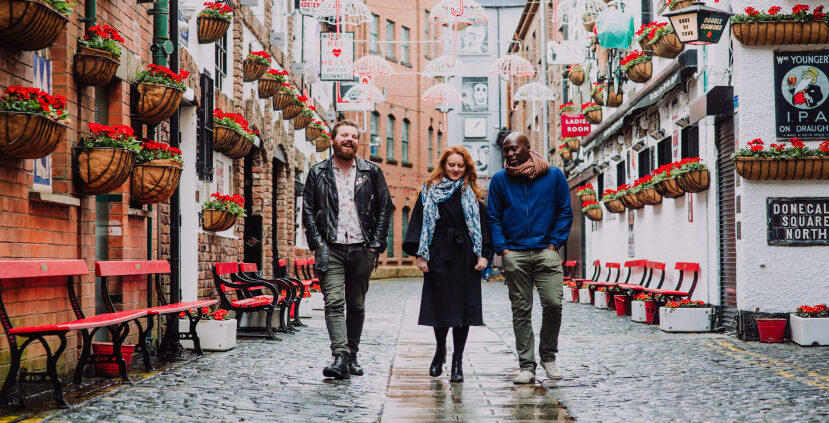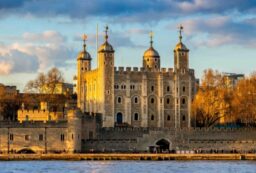
Narrow steeples of cathedrals, the long arms of the iconic yellow cranes Samson and Goliath, Victorian glass-domed buildings and slender modern infrastructures dominate the Belfast skyline. Such a unique combination of sites, history, and architecture has culminated into the Belfast we see today. Spending time in the city will reveal some of the most pivotal moments in both Irish and world history and will create a deeper appreciation for Irish history, culture, and industry.
The largest city in Northern Ireland, over 600,000 people live in the metropolitan area and within the city limits of Belfast. The city is situated in both County Antrim and County Down, two of the six counties located in Northern Ireland. The River Lagan, which is often the site of rowing clubs practicing, weaves through the city with Victorian iron-wrought bridges and modern bridges connecting the city from coast to coast. The river flows out of the city, emptying out into the Irish sea, passing by the Titanic docks and, further on, Carrickfergus Castle. From a wide variety of architecture, from Georgian homes to Victorian and modern business and government buildings to a vast number of parks, churches, as well as the prestigious Queen’s University and the Belfast zoo, the many cultural influences in Belfast are apparent.

While such aspects of the city must be appreciated, one cannot fully understand Belfast without delving into its past. The city has a long and complicated history that is inextricably linked to its identity and crucial in understanding and admiring the Belfast that we know of today. Belfast started as a medieval town that slowly turned into an industrial hub by the 1800s. Such industrial advancements saw the infamous Titanic constructed in the city in the largest shipyard in the world of its time.

Belfast is most known historically as the scene of The Troubles in the 20th century. A critical time in Irish history, Belfast faced violence and destruction amidst conflicts between Catholics and Protestants with countless bombings and attacks on both sides as they vied for control over the city. From the famous murals depicting scenes of the Troubles and hunger strikes to the immersive Titanic museum to the legendary Giant’s Causeway, Belfast is a city built by strife, passion, and nature’s strangest phenomena to make it what it is today.

There are so many things to see and do in Belfast that a short stay is almost impossible. But one tour that is a must for any visitor to Belfast is the Black Taxi tour. This award-winning tour has carried out tours for over 20 years, earning accolades for its in-depth telling of some of Belfast’s darkest and most important years in the 20th century. Guests can book a black taxi tour and be picked up right from their hotel to learn detailed accounts of Belfast during the time of The Troubles. The taxi driver takes guests around the city while explaining the important landmarks that were significant for the people of Belfast and for all of Ireland. For instance, did you know that the most bombed hotel in Europe, Europa Hotel, is found in Belfast and still stands today? The tour will take you by this very hotel and explain the history of some of the bombings that occurred there.

These tours also show guests the murals found on countless walls throughout the city and its suburbs. Painted over the last century, the murals tell stories of the conflicts between the Catholics and Protestants, from images of soldiers to memorials of those who died fighting for their cause. The tour will even take guests to the peace wall that still stands today. The black taxi tour stops at this stretch of wall to show guests the paintings and thousands of signatures from people across the world.
The black taxi tours are just the beginning of what Belfast has to offer. No trip to any city in Ireland or Northern Ireland is complete without a visit to a place that is steeped in mystery and legend. An hour outside of Belfast is the famous Giant’s Causeway. The mythical draw of the Giant’s Causeway has lured visitors to its hexagonal stone columns for centuries. With a modern visitor’s center that tells both the mythical and scientific cause of the causeway’s creation, the fascinating site sits just a short walk from the center. Guests can walk on these strange rock formations while taking in the crashing waves of the Irish Sea. On a clear day, visitors can even see the coast of Scotland, where the Scottish giant Benandonner supposedly ran from the great Irish hero, Fionn MacCumhaill, causing the breaking of the stone columns into the sea.

"Spending time in the city will reveal some of the most pivotal moments in both Irish and world history and will create a deeper appreciation for Irish history, culture, and industry. "

While going a little outside of the city allows for some of the most spectacular views of the Irish sea, back in Belfast, the city holds some more extraordinary sites. Everyone knows about the ill-fated Titanic which sank in the Atlantic in 1912, but few can actually say that they went to the very site where the Titanic was built. Belfast is the home of the Titanic and is now home to the renowned Titanic museum. This immersive museum is grand in size and takes visitors on a journey from the creation of the Titanic all the way to its demise. The self-guided museum has over 9 interactive galleries that go into great detail about the different aspects surrounding the Titanic, from the passengers aboard to the builders and planners who made the ship possible.At the end of the tour, visitors can go outside and not only walk the layout of the ship but also see the historic slipways that launched the Titanic out to sea. A simple but moving memorial for the victims of the Titanic also sits outside for guests to visit.

"From the famous murals depicting scenes of the Troubles and hunger strikes to the immersive Titanic museum to the legendary Giant’s Causeway, Belfast is a city built by strife, passion, and nature’s strangest phenomena to make it what it is today."
Fully enjoying the sites within and around Belfast means having that perfect place to stay. The Merchant Hotel is Belfast’s jewel, the Victorian and art-deco style hotel drawing affluent travelers from across the world for many years. The five-star hotel is located in the historic Cathedral Quarter, just a short walk from St. Anne’s Cathedral. This luxurious hotel was once a bank all the way back in 1836 and has maintained its elegant Victorian features ever since. Guests can choose to stay in an Art Deco room, a Victorian bedroom, or enjoy the height of everything the Merchant Hotel has to offer in the Brian Friel suite, named after Irish writer, Brian Friel. Each room uses subtle approaches to ensure the decor matches the theme of each room so that guests feel that they are back in the late 19th century or early 20th century with all of the luxuries of a modern upscale hotel.

The Merchant hotel has an internationally recognized and award-winning cocktail bar, a dreamy rooftop garden with its own bar, and a champagne lounge reminiscent of 1920s France. The acclaimed Great Room Restaurant sits in a grand room and offers a 6-course tasting menu under crystal chandeliers, arched ceilings, marble pillars, and a glass dome ceiling.
The Great Room Restaurant isn’t the only fine-dining establishment in Belfast, however. Overlooking Oxford Street on the River Lagan is OX Belfast, a Michelin-star restaurant that focuses on Modern European cuisine. With its mid-century and modern-style decor and tall windows opening out onto the river, this bright and airy eatery has become one of the finest restaurants in Northern Ireland. First opened in 2013, OX Belfast has won many awards for its service and food with its 6-course sample tasting menu that incorporates some of Ireland’s finest ingredients. Unique to this fine-dining institution is its drink list exclusively for Irish drinks and spirits to ensure guests get the best tasting of everything Ireland has to offer, from classic Irish whiskeys to gins distilled across Ireland.

Influenced in its own right by conflict, culture, and industry, Belfast has become a source of inspiration for many. Bands like U2 and Snow Patrol as well as singers like Elton John have dedicated songs to this historic city, and upon visiting it, it becomes clear why Belfast leaves such a lasting impression on those who enter.

The painful past of the Troubles is ingrained in the people and buildings of Belfast today, the legacy of the Titanic remains an important part of Belfast history, and the not so far off Giant’s Causeway reminds us that Belfast is still a place of ancient standing. It’s influence continues to inspire many today and is waiting for anyone wanting to visit to experience its countless wonders and learn about its valuable history.
















